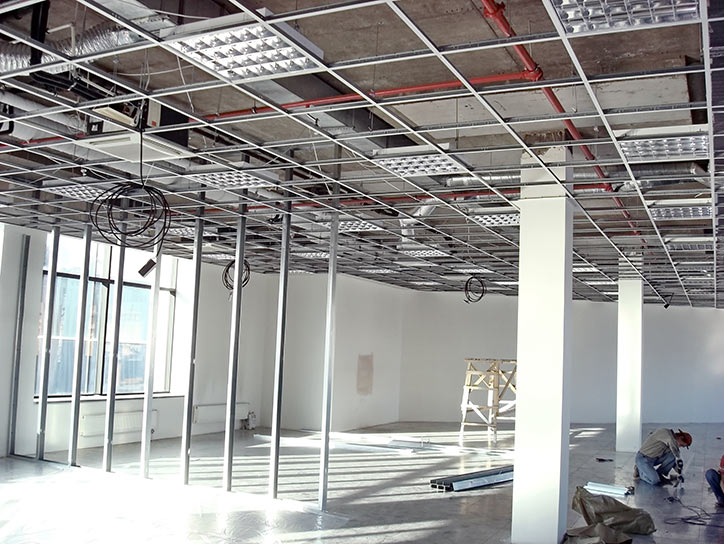Plaster Repairs: A DIY guide for the home and office
If you have plaster walls, it’s essential to keep them maintained. Keeping your walls in good condition is much easier when done regularly than waiting until there are problems with cracks or holes that need to be filled in. There are many ways of repairing a damaged wall; this article will cover some common mistakes and give easy do-it-yourself methods to correct any problem on those old plastered surfaces! Plastering Guys at 26 Mair Street Turvey Park NSW 2650 can also help with ideas if you get stuck too!
Plaster Repairs Definition
Plaster repairs are often needed when your walls begin to show signs of age due to the elements and other factors. The process involves applying different layers of selective materials that will protect against further damage while also helping preserve the original shape of a wall or ceiling. This can be done by injecting mortar into your drywall cracks before painting over them with spackle. Another option would be using plaster patches and finishing coats, which protect small areas where there was once visible water penetration and eliminating odours caused by mould growth. Maintaining your plasterwork is essential because it helps keep moisture at bay, so you don’t have any problems like leaky ceilings or cracked foundations!
Ideas for DIY Plaster Repairs
DIYs are the best option for repairing plaster damage when you don’t want to spend too much time on them.
The following blog post will show you how easy DIY repair can be with a few simple tools and methods!
Crack Repairs
Cracks can not only mar the appearance of a house, but they also have the potential to damage its structural elements if left unattended. Fortunately, there are many tools you’ll need for repairing any cracks in your home – and all it takes is some joint compound! You will require: A scrapper; cloth pieces (to clean dirt from holes before applying filler); putty knife; paint or primer; sandpaper blocks with fine grits such as 120-grit up to 300-grit depending on how big of an area needs filling/repairing. Once these materials are collected together, use them like so: Scrape away loose material around the hole’s edges by using a scraper, carefully following contours where possible while wearing protective gloves.
Fixing Holes
With a simple repair kit, you can save the day. Get your hands on an appropriate patch and plaster to fill up any holes or cracks that require repair! The first step is removing all old paint edges around the Hole (or area). After it’s clean, dampen with water for better adhesion before applying both patches and plasters together over the top of the drywall joint compound. Let set overnight to ensure the best results!
Common Mistakes during Plaster Repairs
Many people make one mistake during plaster repairs to cover the Hole with a new layer of mortar. Doing this can further damage your original surface, which may need an expensive restoration process or repair work.
A professional can fix cracks and holes more efficiently. On the other hand, the DIYer might not be able to see which mistakes they’re making that could lead them into further plaster damage territory. For this reason, it’s better to hire a pro for the job, so you don’t end up with any unforeseen consequences!
Essential dust removal of old plaster
Dirty surfaces are a common problem when doing DIY, but it is important to note that this makes the bonding of filler or patch with existing areas less stable. If you do not clean your surface properly first, dust and grease will remove materials from these damaged portions much more complex than if they were cleaned beforehand. The older parts of plaster provide strong bonds between themselves and other structures beneath them; however, cleaning before old pieces are removed can prevent damaging larger sections as well by keeping what remains in place better.
Applying an improper damp layer
Applying a damp layer is essential to the process of filling walls. The new surface needs a good bond with what’s already there, and water damps it down so that new compounds can adhere well without leaving any ugly gaps or bumps in the wall. It also helps to make sure you have everything covered before moving on to the next step- which saves time by not having to go back over spots for missed bits later!
Wrong filler material selection
Some fillers can be used inside and outside, but others are only for indoors.
Different materials have different abilities to keep moisture out or in; for example, and some will not let water vapour escape while others may allow the structure of a building envelope to breathe freely. It is essential to know what you need before purchasing since buyers might end up with products they don’t want after purchasing them. The more information you can have about the product upfront, the better off both buyer and seller could be because there won’t be any unnecessary returns due to confusion on which kind of filler material was desired by one party or another when placing an order online.
Quick Fix Plaster Repairs to Walls
I’ve had cracks in my wall for a while now, but I never thought about fixing them. It’s so easy too! All you need is some plaster, sandpaper and putty knives. Then, you only have to mix the two with water and wait until it sets up before applying to your walls!
It seems some people are always looking for quick fixes these days. And if something can be done quickly without any fuss? That sounds good to me because who has time nowadays?! So here we go: how do those of us that may not know much about home repairs fix holes or cracked walls on our own homes? In reality, it turns out all you really need are three simple items (plaster powder, sandpaper and putty knives).
Tools and Materials Required for Repairing Plaster Walls
Fixing plaster on your walls can be a challenging task. It would help if you had the best tools and materials to do it right, or else you’d have some serious issues down the line. With that in mind, here’s what you will need:
● Small to Medium-Sized Putty Knife or Trowel
● Mixing tray for plaster
● Sandpaper or sponge for finishing and dampening
● Jointing compound or pre-mixed plaster compounds
● Primer and paint for finishing
● Drier if required due to cold temperatures
7 Steps for Quick Plaster Repairs to Walls
Step 1: Cleaning out the cracks & holes.
In a plaster repair, make sure you clean the repaired surface first. It may seem an unnecessary step at first glance, but it is essential to get any dirt or debris out of cracks and holes to bond between old plaster and new compound. If there are still particles left on surfaces where you have applied your patching material, this will not be very good for cohesion as they could cause gaps in the bond line, making them weak points, which may lead to future breakage down the road.
Step 2: Wetting The Treated Surface
To begin this job, prepare yourself to get your hands dirty. First, moisten the walls for them to stick better and then use a mixture of adhesive from home or purchase some new stuff from stores explicitly designed for plastering.
Step 3: Preparing jointing compound
Mixing the suitable material can be difficult, but there are ways to get it done. Quick-setting time varies from 20 minutes up to 90, so you have many options depending on how much work needs to be finished in one day. From personal experience, I’ve found that 45 minutes is perfect for almost any job because it’s an hour and 15-minute margin if something comes up unexpectedly, like car trouble or another emergency later in the evening after work. Compounds come with all sorts of different thicknesses, which is why having a rectangular tray when mixing materials will help create your peanut butter consistency quicker without too many issues.
Step 4: Fill the Cracks and Holes
After mixing water into the jointing compound, your race with time begins. You have to fill all of the faulty surfaces within the mentioned amount of time for your new coating on the character you want to conceal. Pick up whatever utensil you feel more comfortable handling and take some plaster mix out onto that uncoated area in need or fix-up work; cover it evenly right away so when mixed, this slimy consistency has an easier chance at filling any cracks or holes present from missing parts once before – just like putting icing over cake batter!
Step 5: Let your compound dry
Use a plaster dryer to speed up your repairs. Instead of waiting for days or weeks, it will take only seconds! But if you do not have one on hand, the surface might require some time before completely drying out.
Step 6: Rub your filled surfaces with sandpaper or sponge
You can make your plaster surface even with the old one by sandpapering it or using a sponge. This choice is really up to you, but remember that if you use a wet sponge, be sure you don’t overdo it because this may tear apart your fill and reduce the time-saving benefits of finishing quickly.
Sanding your walls is a task that can be avoided with the right materials. A sponge or 120-grit sandpaper will make sure you don’t have to agonize over any gaps in between old plaster and new fill material, saving time while keeping everything even and looking great!
Step 7: Painting the walls to cover up your plaster repairs
It is crucial to make your repaired area appear as if you were never treated for any damage in the final step. Using an identical pigment or paint colour will give people who know nothing of a seamless appearance with no visible markings anywhere on the surface.
Plasterboard Repairs: Repairing the holes in Plasterboard walls
If you live in a home with plasterboard walls, then it is likely that at some point, there has been damage to the wall, which has left holes. This can happen due to wear and tear or just an accident when someone bumps into the plastered surface.
Repairs on plasterboard can be tricky, but it’s not difficult with the right tools and know-how. For repairing holes in plasterboards, you need a few things:
- Your materials of choice (e.g., filler, spackle), skills to repair delicate surfaces.
- Patience when waiting for plaster coats to dry before smoothing out all imperfections from the surface.
- Time depending upon how large an area needs treatment.
Repairing small holes is just about scraping away any debris that has got into them while fixing bigger ones takes more work due to increased area – use plenty of adhesives when filling up holes, so they don’t come back!
Using a section of plasterboard to conduct repairs:
Safety checks before you start repairs:
Before you start cutting the plasterboard for repairs, make sure there are no wires or pipes that may be accidentally cut. You can use a wire detector to find these items before the damage happens and then mark them with paint, so they don’t get covered up by your work when it’s all over.
To avoid accidents while repairing wall damages due to water leaks from broken pipes, you should check beforehand whether any electrical cords or piping might be damaged too; this way, if anything does go wrong during repair time, we won’t have two problems with our hands!
Slice up some square plasterboard to cover the Hole:
To give the plasterboard a square shape, you first need to measure and cut each corner. For this step in the process, you must make sure your cuts are up to where there are cracks for an even seal. You can use any of these tools: pad saws or hobby knives will do just fine!
Slice up a repair patch:
Since you have widened the Hole, make sure to use the plasterboard of a similar size that will fit in properly. For that purpose, measure and cut out your patch accordingly so it can pass through your newly enlarged space flawlessly!
Screw it to the centre of your patch:
You should drill a hole in the centre of your patch and screw it into place at this stage. The screws will help position the patches until they dry out. Upon drying time, push them hard enough so that they fall back inside their holes on both sides of the wall void!
Adding Some Adhesiveness:
To ensure your patch stays in place, use any heavy-duty construction adhesive to apply all around the edges. Then, apply a dab of glue onto both surfaces and press them together for 1-2 minutes before allowing it to cure for 24 hours.
Placing a patch in the Hole:
First, use a screwdriver to hold the pitch from the head of your screw and then tilt it inside for it to go into that Hole. Now divide up all this adhesive to have something juicy on both sides when sticking them together like glue. Once this is done, make sure not to press down hard with your hands or anything else because if you do, things won’t turn out quite as well as they could’ve turned out otherwise, which would be disappointing after all those hours spent getting everything ready right beforehand!
Filling the Hole to complete your plasterboard repairs:
The adhesive is dry, and you’re onto the next step of your home improvement project: filling in the Hole. This will help avoid any bumps or uneven surfaces on top of it when you move back downstairs to use a trowel for that final decorative touch once it has dried off again.
Local Council Laws In Wagga Wagga NSW 2650
It’s also important to adhere to local government laws when it comes to creating construction hazards no matter how innocuous you may feel the work to be carried out is. You may be in breach of local bylaws such as operating hours for machinery and other hazards such as dust, waste or electrical equipment so be sure to conduct your own due diligence to be confident you are complying.
Plaster Repairs: A DIY guide for the home and office
If you have plaster walls, it’s essential to keep them maintained. Keeping your walls in good condition is much easier when done regularly than waiting until there are problems with cracks or holes that need to be filled in.
Suspended Ceilings: What Are They?
Suspended Ceilings: What Are They? A suspended ceiling is a type of suspended structure that divides space into different levels. This suspended ceiling usually consists of several lengths of metal or wooden beams and horizontal surfaces suspended from the top, with columns in between to support each beam at regular intervals. Suspended ceilings are also […]
Reasons Behind The Cracks In Your Plaster
Reasons Behind The Cracks In Your Plaster Whenever structural elements get subjected to load, internal or external, and when the stresses exceed the permissible limits of pressure for that particular material upon which it’s constructed. This will lead to cracks in the structure and potentially catastrophic failures if not dealt with immediately. All houses should be designed […]




